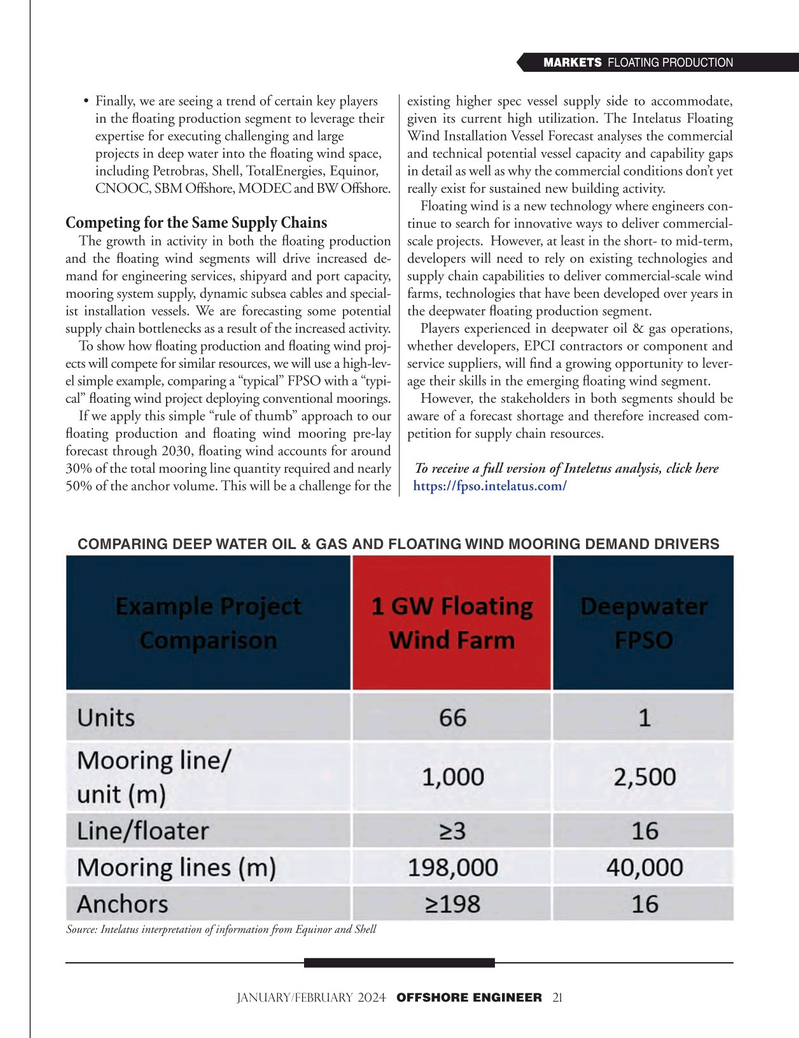
Page 21: of Offshore Engineer Magazine (Jan/Feb 2024)
Read this page in Pdf, Flash or Html5 edition of Jan/Feb 2024 Offshore Engineer Magazine
MARKETS FLOATING PRODUCTION • Finally, we are seeing a trend of certain key players existing higher spec vessel supply side to accommodate, in the foating production segment to leverage their given its current high utilization. The Intelatus Floating exper tise for executing challenging and large Wind Installation Vessel Forecast analyses the commercial pr ojects in deep water into the foating wind space, and technical potential vessel capacity and capability gaps including Petrobras, Shell, TotalEnergies, Equinor, in detail as well as why the commercial conditions don’t yet CNOOC, SBM Offshore, MODEC and BW Offshore. really exist for sustained new building activity.
Floating wind is a new technology where engineers con-
Competing for the Same Supply Chains tinue to search for innovative ways to deliver commercial-
The growth in activity in both the foating production scale projects. However, at least in the short- to mid-term, and the foating wind segments will drive increased de- developers will need to rely on existing technologies and mand for engineering services, shipyard and port capacity, supply chain capabilities to deliver commercial-scale wind mooring system supply, dynamic subsea cables and special- farms, technologies that have been developed over years in ist installation vessels. We are forecasting some potential the deepwater foating production segment. supply chain bottlenecks as a result of the increased activity. Players experienced in deepwater oil & gas operations,
To show how foating production and foating wind proj- whether developers, EPCI contractors or component and ects will compete for similar resources, we will use a high-lev- service suppliers, will fnd a growing opportunity to lever- el simple example, comparing a “typical” FPSO with a “typi- age their skills in the emerging foating wind segment.
cal” foating wind project deploying conventional moorings. However, the stakeholders in both segments should be
If we apply this simple “rule of thumb” approach to our aware of a forecast shortage and therefore increased com- foating production and foating wind mooring pre-lay petition for supply chain resources.
forecast through 2030, foating wind accounts for around 30% of the total mooring line quantity required and nearly To receive a full version of Inteletus analysis, click here 50% of the anchor volume. This will be a challenge for the https://fpso.intelatus.com/
COMPARING DEEP WATER OIL & GAS AND FLOATING WIND MOORING DEMAND DRIVERS
Source: Intelatus interpretation of information from Equinor and Shell january/february 2024 OFFSHORE ENGINEER 21

 20
20

 22
22